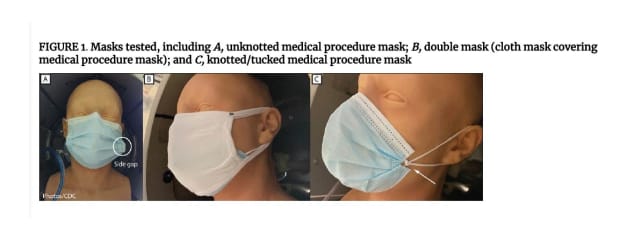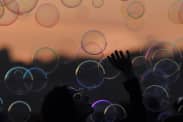It looks like wearing two masks is indeed better than one.
While Dr. Anthony Fauci and some other public health experts have suggested that double-masking may be more effective in protecting against COVID-19 than a single face covering, the Centers for Disease Control and Prevention hasn’t endorsed the method — until now.
The CDC has updated its mask guidance to include masks that “fit snugly against the face” as well as masks with more layers to stop respiratory droplets from getting in or out. And one recommended way to layer up includes wearing two masks; specifically, a disposable surgical mask underneath a cloth mask that pushes the edges of the inner mask against the face.
CDC: Double masking is more likely to protect against the coronavirus
These new recommendations are drawn from a recent lab experiment, CDC director Dr. Rochelle Walensky announced on Wednesday, which studied the effectiveness of different masking techniques by placing two artificial heads a socially-distanced six feet apart from each other, and seeing how many coronavirus-sized particles were exhaled by one head and inhaled by another.
The most effective masking technique was when both heads double-masked by wearing a cloth mask on top of a surgical mask, which blocked more than 95% of the viral particles. When just one head double-masked this way, and the other remained unmasked, this method still managed to block about 80% of particles coming from the unmasked head.

That doubled the protection gained from wearing just one mask — either surgical or cloth — which blocked around 40% of particles. Still, studies have shown that wearing something on your face is better than nothing, so continue to mask up even if you only have access to a single cloth mask at the moment. The confirmed global COVID-19 case count topped 107 million on Wednesday, and the death toll climbed above 2.42 million. There have been more than 27 million cases in the U.S., and more than 468,207 Americans have died.
Read now: CDC director: ‘Now is not the time to roll back the mask requirements’
It should be noted that not all double-masking is created equal, however. The CDC does not recommend wearing two disposable surgical masks, since these are not designed to fit tightly, so doubling them up will not improve the fit the same way that putting a well-fitted cloth mask over a surgical mask can. What’s more, you should only use one KN95 mask at a time, as they are already certified to filter out at least 95% of very small particles. So don’t double up on them even if you can actually get your hands on any.
The seal of the mask is just as important. Make sure the mask fits snugly over your nose, mouth and chin by cupping your hands around the outside edges of the mask, and making sure no air is flowing from the area near your eyes or the sides of your face while you’re wearing the mask. And if the mask fits well, you should feel warm air come through the front of the mask, the CDC adds, and you may even be able to see the mask material move in and out with each breath.
The CDC also recommends choosing a mask with a nose wire — a metal strip that can be bent over your nose to prevent air leaking out from the top of the mask.
Another way to make your mask fit better is by the “knot and tuck” method: knotting the ear loops of the medical procedure mask, and then tucking in and flattening the extra material close to the face. Indeed, when both of the heads were wearing masks that were knotted and tucked, they were able to block about 96% of viral particles. When just one head was wearing a knotted and tucked mask, it was still able to block a little more than 60% of the particles.
You can see a “knotted and tucked” mask in the third image on the far right here.
Check out the CDC’s updated mask guidance here.
And follow MarketWatch’s coronavirus coverage here.






